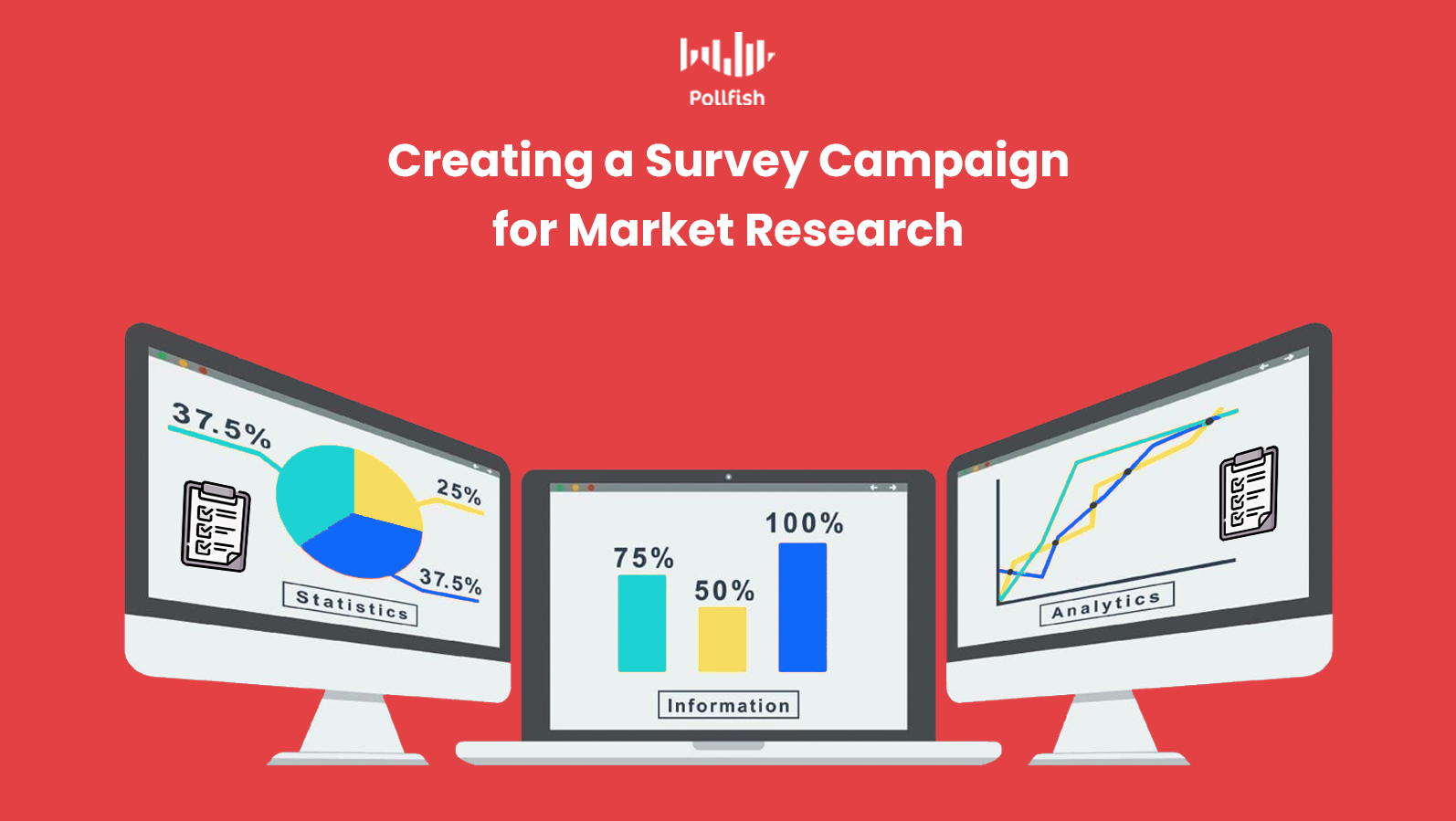How to Build a Strong Survey Campaign for Market Research
 A strong survey campaign is invaluable for market research. This is because survey studies provide the most potent means of gathering your own unique research — primary research, that is.
A strong survey campaign is invaluable for market research. This is because survey studies provide the most potent means of gathering your own unique research — primary research, that is.
A survey campaign is part of a far larger endeavor, as it is just one methodology in a research campaign. Thus, it requires more than merely being planned out; researchers must decide on one of the types of research to conduct before settling on a survey.
There’s also more when it comes to producing a strong survey campaign. This article explains this in full detail, so that businesses and market researchers can create surveys that reap the most insights.
Defining a Survey Campaign
A survey campaign is a series of efforts used to gain firsthand data from a target market in market research, or a target population in general research.
This kind of campaign is a primary research method in which researchers attempt to find a solution to a problem. For example, it can focus on the problem they would come upon in descriptive research.
But there’s much more to survey campaigns. Although they can be used to resolve problems discovered in a type of research, such as exploratory, causal, etc., they can be used for a wealth of other purposes.
When it comes to business, a survey campaign can determine if a new strategy will be beneficial, detrimental or affect little to no changes. What even more important is that such a campaign allows businesses to understand the lifeblood of their business: their customers.
What a Survey Campaign Helps Reveal for Your Business
Dovetailing off of the previous section, there are many things a survey campaign can help a business achieve. Some of these go beyond market research itself.

Here are some of the other purposes a survey campaign helps serve:
- Understanding the makeup of your target market
- Via the target market survey
- Market segmentation for further segmenting
- Testing a creative strategy for a number of macro applications such as
- Advertising
- Branding
- PR
- General marketing
- Obtaining customer feedback and getting a deep read of your target market
- Via a customer satisfaction survey
- Includes the NPS, CSAT, CES, visual rating survey & more
- Discovering the CLV (customer lifetime value)
- Via a customer satisfaction survey
- Excelling in product endeavors
- Testing product satisfaction
- Innovating products with new features and upgrades
- Understanding how your product compares with competitors’
- Avoiding negative publicity
- Regular checks on the opinions of your brand
- Finding customer aversions to avoid in your messaging and brand’s image
- Obtaining employee feedback
- Running a pulse survey
- Via the employee satisfaction survey
- Improving your CX
- Via a customer experience survey
- Using a survey for content marketing strategy
- Driving Lead generation
- Includes B2B endeavors
- Helps you learn more about the specific needs and desires of your target market, or B2B clients such as partners, vendors and other businesses.
- Acclimating with your niche
- Allows brands to keep up with market and niche trends
- Makes it easier to change with the times
- Completing a market analysis
- Being able to compare your brand with others
- Getting a feel of the thoughts and attitudes in your overall space
Proving the Value of a Survey Campaign
While many brands turn to market research, they do not always carry it out successfully. With primary research specifically, it is more difficult to reap accurate, bias-free insights, as it involves far more than just an analysis, but the labor of conducting the research yourself.
Additionally, a business may encounter the issue of biases, a lack of participants and even responses that are hard to draw conclusions from.
A survey campaign provides the antidote to all of these problems — when conducted correctly, that is.
A survey campaign is useful for reasons beyond the 10 in the aforementioned list. Here are a few ways this kind of campaign is a must for businesses:
Since surveys help measure the CX (customer experience), they inform businesses on a variety of touchpoints that influence their CX and how they do so. This is important, as 86% of buyers are willing to pay more for a good CX. Thus, a business can improve its customer experience, which will therefore increase sales.
76% of customers expect businesses to understand their needs. A properly designed survey campaign will do exactly this. This is because you can create a number of different, although related surveys under one campaign. By creating diverse surveys, you can study a more diverse set of segments in your target market. This kind of research will help you understand and adapt to their needs.
When it comes to branding and customer loyalty, businesses can stand to run a survey campaign for a variety of reasons. First off, 86% of consumers believe that authenticity is important when they decide on the brands they choose to support.
Surveys can also help in brand recognition; simply deciding on a correct signature color can spur brand recognition as high as 80%. Creating a survey campaign with visually-oriented surveys can achieve this.
Then comes the sensitive issue of news and culture, particularly social and political issues. 64% of consumers from across the globe said that they would either boycott or buy from a company simply for its political or social stance. A survey campaign allows you to quiz your target market on its thoughts surrounding current affairs so that you take the correct position or none at all.
How to Build a Survey Campaign
The following explains how to set up a survey campaign, ensuring you use the correct surveys, frequency and other functions within your campaign.
- Find what it is you need to study; consider the things that matter to your business and have little to no research, such as what you would use in exploratory and explanatory studies.
- Or, if you have already conducted exploratory or explanatory research, consider other related factors or issues that you’d like to study.
- Once you find a topic of study, which can be any business phenomenon, for example, a decrease in sales of a particular product, tie it to a larger purpose or campaign.
- For example, perhaps it fits into branding more, or perhaps it is an advertising issue.
- When you’ve affixed your campaign with a macro-application (ex: advertising), decide whether you’ll need to run one or several surveys.
- Consider conducting causal research on the matter, as this will find cause and effect relationships and since survey launches are one of the last steps of the entire research process.
- If you perform this research and discover cause and effect relationships, you may need to rework your intentions or original questions.
- Come up with several questions. An ideal starting point is to sift through the 6 main types of survey questions and to deliberate which will be of most use.
- Using the question types as question templates, form your questions.
- When you’ve come up with 10-15 questions, consider cutting them and organizing them into two or more surveys. (Shorter surveys have greater response rates).
- As you organize your questions, create the appropriate theme for each survey.
- Create a callout that briefly explains what the survey is for.
- Customers are fond of transparency.
- Here you can mention that the survey is to improve their own CX, or that their opinion matters.
- Use a strong online survey tool to create, launch and run your survey to the correct target market.
- Perform a survey data analysis and jot down key findings.

- Use your findings to draw a conclusion about a hypothesis, or continue doing further research, such as correlational, causal or even experimental.
- Your original results will bring key findings that answer your work’s key questions, answer a hypothesis or prompt further research.
- This may require further survey research.
Consolidating Your Research
A research project often manifests as a long and winding process, rife with several sub-campaigns and tasks. A survey campaign can help tame this process, easing the way to finding key results.
This is because surveys provide agility and speed to insight — when conducted correctly. It is virtually impossible to find hundreds or even thousands of respondents that properly fit your target population, let alone convince them to take a survey.
That’s where an online survey tool offers a multitude of value, as it can carry out these tasks and more, with little to no effort from you. A strong online survey tool is thus a necessity for your survey campaign needs.
Pollfish Marketing Team
Ready to Try Pollfish?
Create your survey with AI, target high-quality respondents starting at $0.95 per complete, and start getting results in just minutes in real-time. From running a simple product concept survey to managing a constant stream of trackers for dozens of clients in dozens of countries, we’ve got you.

